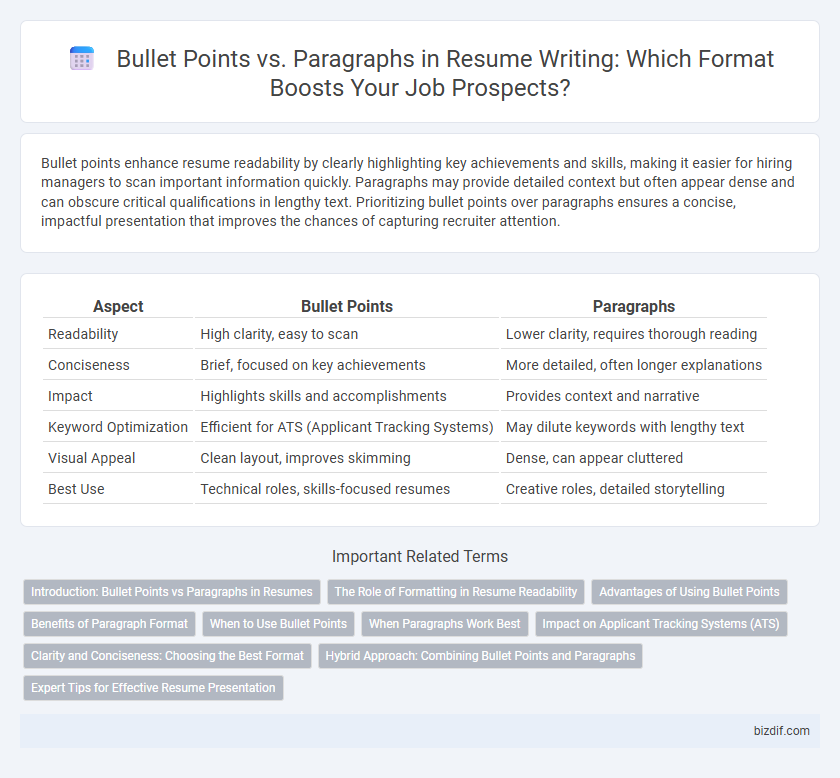Bullet points enhance resume readability by clearly highlighting key achievements and skills, making it easier for hiring managers to scan important information quickly. Paragraphs may provide detailed context but often appear dense and can obscure critical qualifications in lengthy text. Prioritizing bullet points over paragraphs ensures a concise, impactful presentation that improves the chances of capturing recruiter attention.
Table of Comparison
| Aspect | Bullet Points | Paragraphs |
|---|---|---|
| Readability | High clarity, easy to scan | Lower clarity, requires thorough reading |
| Conciseness | Brief, focused on key achievements | More detailed, often longer explanations |
| Impact | Highlights skills and accomplishments | Provides context and narrative |
| Keyword Optimization | Efficient for ATS (Applicant Tracking Systems) | May dilute keywords with lengthy text |
| Visual Appeal | Clean layout, improves skimming | Dense, can appear cluttered |
| Best Use | Technical roles, skills-focused resumes | Creative roles, detailed storytelling |
Introduction: Bullet Points vs Paragraphs in Resumes
Bullet points in resumes enhance readability by highlighting key skills and achievements, allowing recruiters to quickly scan and identify relevant qualifications. Paragraphs provide a narrative form that can explain complex experiences but risk becoming dense and overlooked by hiring managers. Optimizing resume introductions with concise bullet points increases clarity and ensures critical information stands out effectively.
The Role of Formatting in Resume Readability
Bullet points enhance resume readability by breaking down information into concise, easily scannable segments, allowing hiring managers to quickly identify key skills and achievements. Paragraphs, while useful for detailed explanations, can overwhelm and deter recruiters from thoroughly reading the content. Strategic formatting that incorporates bullet points improves visual hierarchy and ensures essential qualifications stand out efficiently in competitive job applications.
Advantages of Using Bullet Points
Bullet points enhance resume readability by breaking down information into concise, easy-to-scan snippets, allowing recruiters to quickly identify key skills and achievements. They improve organization, highlighting specific accomplishments and job responsibilities succinctly without overwhelming the reader. This format also supports keyword optimization, increasing the chances of passing applicant tracking systems (ATS) used by many employers.
Benefits of Paragraph Format
Paragraph format in resume writing enhances narrative flow and allows for detailed explanations of skills and achievements within a cohesive context. This style enables candidates to present complex job responsibilities and accomplishments with depth, showcasing problem-solving abilities and professional growth. Paragraphs also improve readability for ATS systems by embedding relevant keywords naturally throughout the text.
When to Use Bullet Points
Use bullet points in resumes to highlight key achievements, skills, and responsibilities clearly and concisely, making information easily scannable for recruiters. Bullet points improve readability by breaking down complex experiences into digestible, action-oriented statements, emphasizing measurable results and specific contributions. Reserve paragraphs for brief summaries or job descriptions that require context and narrative flow to complement bullet points.
When Paragraphs Work Best
Paragraphs work best in resume sections that require detailed explanations, such as the professional summary or career objective, where showcasing storytelling and context enhances the narrative. They provide space to highlight soft skills, complex accomplishments, and career transitions more fluidly than bullet points. Hiring managers appreciate paragraphs when assessing candidates' communication abilities and deeper insights into their experiences.
Impact on Applicant Tracking Systems (ATS)
Bullet points improve Applicant Tracking Systems (ATS) readability by clearly highlighting skills and achievements, making key information easily scannable and parsable. Paragraphs often cause ATS to overlook important details due to less structured formatting and dense text blocks. Structuring resumes with concise bullet points enhances keyword detection and overall ATS compatibility, increasing the chances of passing automated screenings.
Clarity and Conciseness: Choosing the Best Format
Bullet points enhance clarity and conciseness by breaking down key skills and achievements into easily scannable segments, making them ideal for recruiters who quickly assess qualifications. Paragraphs, while providing a detailed narrative of experiences, may dilute critical information and reduce impact in fast-paced hiring environments. Optimal resume writing balances bullet points for succinctness and paragraphs for context, aligning with job-specific requirements to maximize readability and relevance.
Hybrid Approach: Combining Bullet Points and Paragraphs
A hybrid approach in resume writing leverages bullet points for clarity and quick scanning, while paragraphs provide context and depth to key achievements. Bullet points effectively highlight measurable accomplishments, skills, and responsibilities, making it easier for recruiters to identify critical information. Paragraphs complement these details by elaborating on unique experiences and storytelling elements, creating a well-rounded and engaging resume.
Expert Tips for Effective Resume Presentation
Using bullet points in resumes enhances clarity by breaking down key skills and accomplishments into easily scannable elements, which recruiters prefer for quick assessment. Paragraphs can be effective for summarizing professional profiles but should remain concise and focused on measurable achievements. Highlighting quantifiable results and action verbs within bullet points boosts the impact of your resume, making it more compelling to hiring managers.
Bullet Points vs Paragraphs Infographic

 bizdif.com
bizdif.com